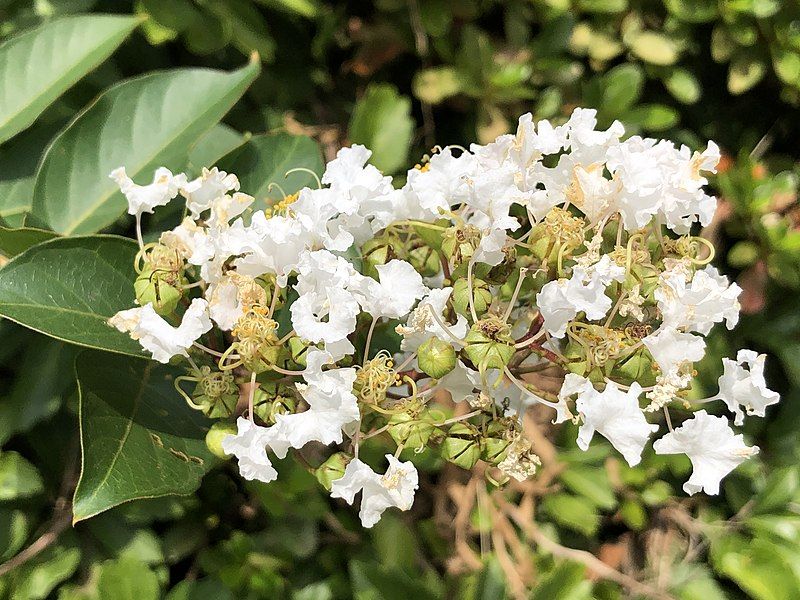Natchez Crape Myrtle Planting Tips, Pruning & More
Looking For A North Georgia Landscaper?
The Dazzling White Crape Myrtle
The Natchez Crape Myrtle (Lagerstroemia indica 'Natchez'), renowned for its dazzling white blooms and stunning cinnamon-brown bark, is a staple in landscape design. This article, brought to you by O'Neill Landscapes, delves into why the Natchez Crape Myrtle is an exceptional choice for your Atlanta garden. It covers everything from planting to maintenance and how this tree can transform your North Georgia landscape into a year-round spectacle.
Why Natchez Crape Myrtle Is a Landscape Favorite
Unmatched Beauty Across Seasons
The Natchez Crape Myrtle is celebrated for its summer display of white flowers and its year-round decorative appeal. In the fall, the dark glossy green leaves transition to striking shades of orange and red, offering a seasonal spectacle. The exfoliating cinnamon-brown bark provides winter interest, making Natchez an excellent choice for sustained landscape appeal.
Adaptability and Disease Resistance
Thriving in USDA hardiness zones 7 to 10, the Natchez Crape Myrtle is a robust and versatile tree that adapts well to various climates, particularly the varying conditions of North Georgia. It is also highly tolerant of powdery mildew, which often affects other varieties, ensuring a healthier and more vibrant tree throughout the year.

Planting and Caring for Your Natchez Crape Myrtle
Effective Planting Strategies
For optimal growth, Natchez Crape Myrtle should be planted in full sun to ensure prolific blooming and healthy growth. The best planting times are during the cooler months of spring or fall, which allow the roots to establish before the stress of hotter weather. This tree prefers well-drained, fertile soil to reach its full potential in height and spread—up to 30 feet tall and 15 feet wide.
Pruning for Health and Aesthetics
For the Natchez, late winter or early spring is the ideal time for pruning. This involves removing dead or crossing branches and shaping the tree to encourage sunlight penetration and air circulation.
Routine Maintenance Tips
Regular watering, especially during dry spells, is crucial for young trees but can be reduced once they are established. A layer of mulch around the base will help retain soil moisture and protect the roots. An annual application of slow-release fertilizer in the spring supports robust growth and flowering.
The Lasting Charm of Natchez Crape Myrtle
Versatile Design Uses
The architectural form and moderate size of the Natchez Crape Myrtle make it ideal for various landscaping applications. It can serve as a striking focal point, line driveways, or be planted in groups to create privacy screens or windbreaks. Its ability to provide year-long interest makes it invaluable in landscape design.
Real-World Landscaping Transformations
At O'Neill Landscapes, we regularly incorporate Natchez Crape Myrtles into our projects across North Georgia, including Blue Ridge, Milton, and Jasper. Our clients are consistently impressed by the tree's stunning visual impact and minimal care requirements.
Enhance Your Landscape with Natchez Crape Myrtle
The Natchez Crape Myrtle offers enduring beauty, ease of care, and robust health, making it a top choice for gardeners and landscape professionals.
If you're in North Georgia and considering this magnificent tree for your garden, or need expert landscaping services, contact us at O'Neill Landscapes. Let us help you create a captivating landscape that celebrates all seasons.
Crape Myrtle, 'Natchez' FAQs
Q How big will a Crape Myrtle, 'Natchez' get?
A mature Natchez crape myrtle typically grows to a height of 25 feet, but can sometimes reach up to 35 feet. It also has a similar width, with a sturdy, arched shape spanning 20-35 feet.
Q Where is the best place to plant a Natchez Crape Myrtle?
The best place to plant a Natchez Crape Myrtle is in a location that receives full sunlight for most of the day. These trees thrive in well-drained soil and can tolerate a variety of soil types, but they prefer slightly acidic soil.




